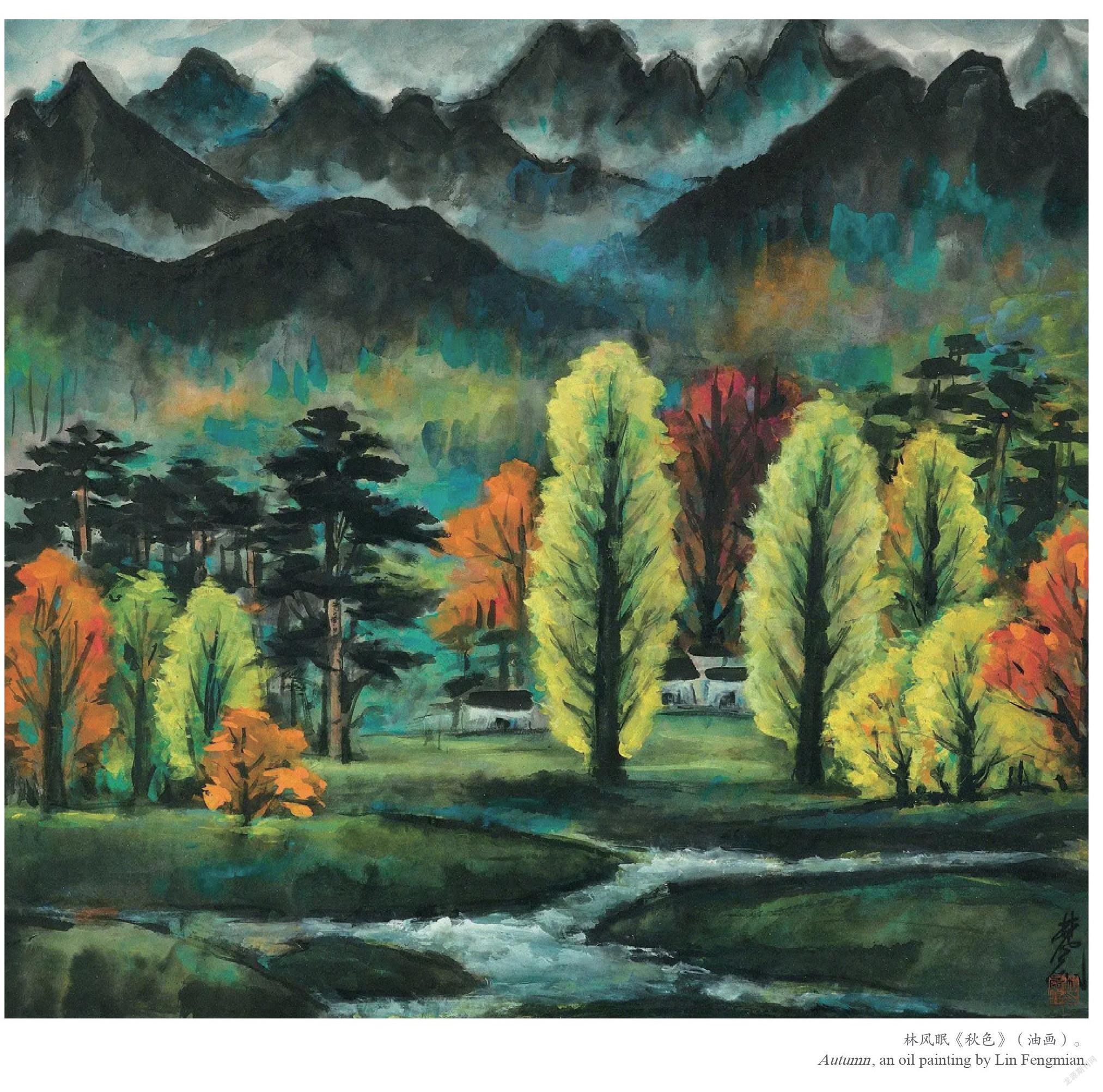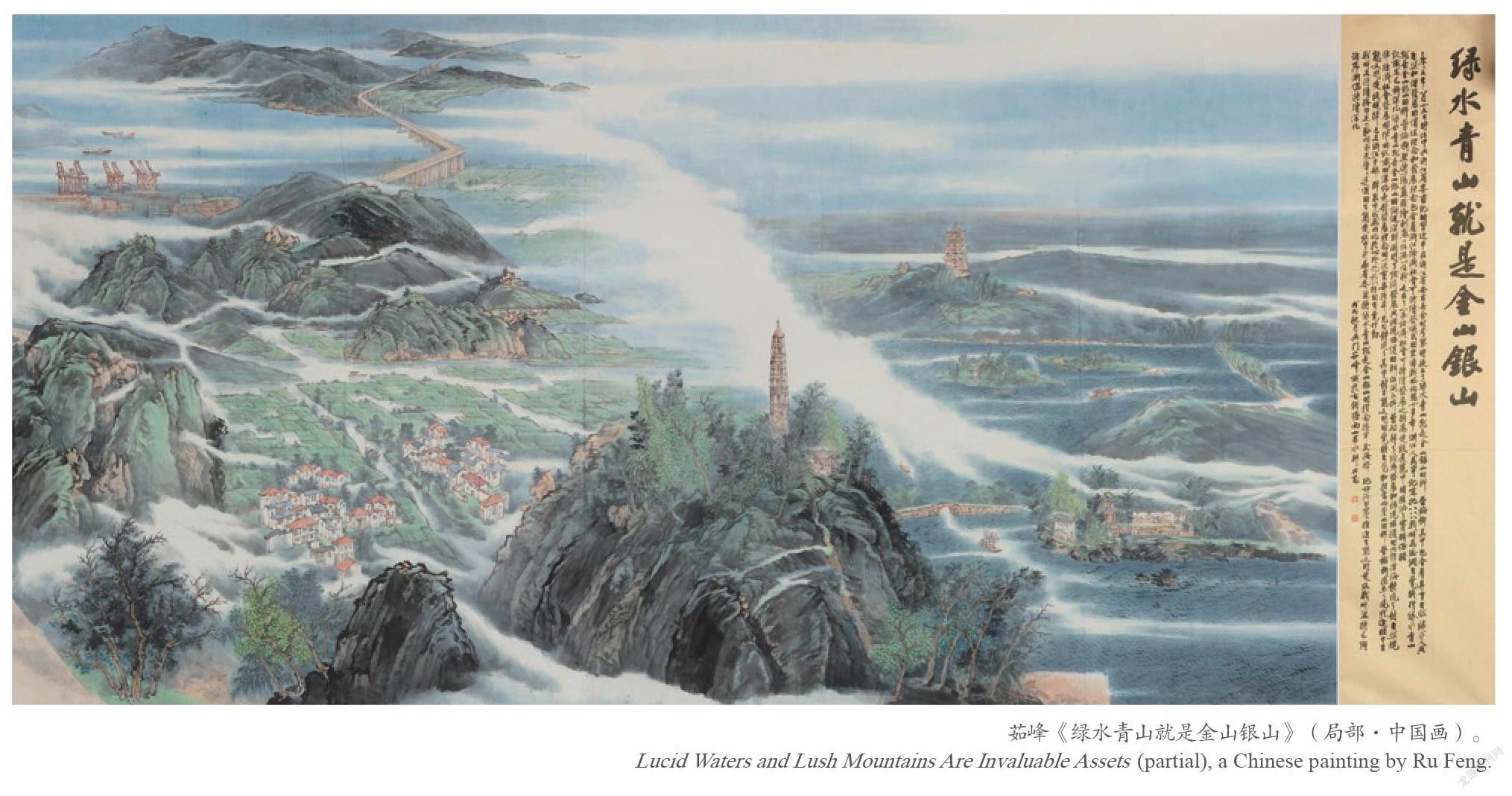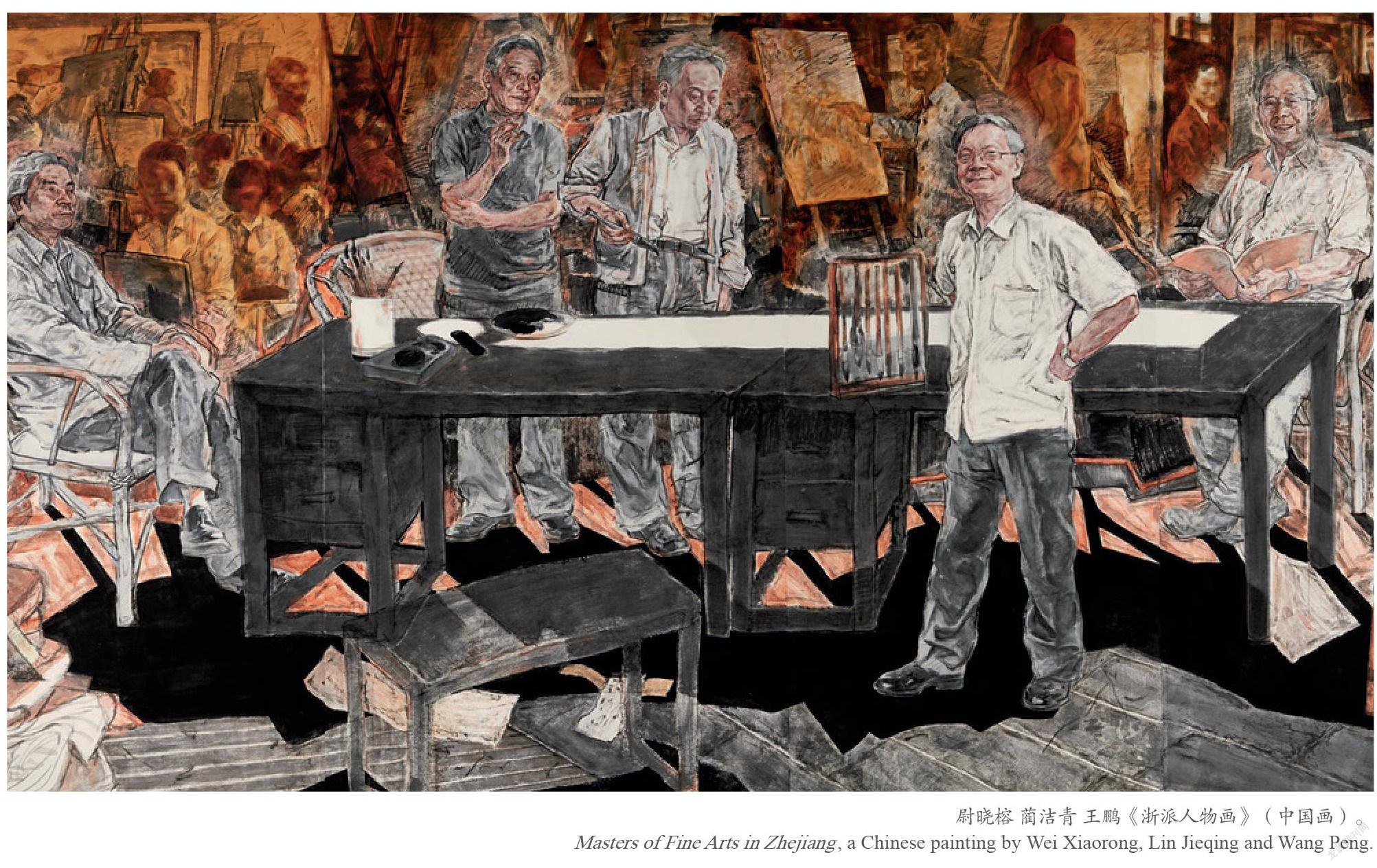浙江美术创作浓墨重彩
王敏杰



浙江大地,山水相依,悠远深厚、意蕴丰富的历史文化传统,滋润和激荡着这里的千里水土、万年人心。从上山文化粗犷质朴的彩陶,到良渚文化温润精微的美玉;从六朝的烟雨山川,到盛唐的吴越盛景;从马远、夏圭们的清远溪山,到黄公望的富春山居;从徐文长的书斋晚风,到潘天寿的雁荡山花……无论是浙派绘画的代代出新,还是中西融合的兼容并蓄,浙江的绘画总是以特有的坚韧和胸襟,博采众长,推陈出新,奠定了在中国美术史上的历史地位。
浙江美术创作,一路走来,名家辈出,佳作如林,群峰竞秀,延绵不绝,历经岁月洗礼,成为一股重要的引领力量凝聚着浙江悠长文脉、历史记忆和精神传统,为丰富和发展中华民族的文化艺术作出了重大贡献。
宋代绘画影响深远 新艺术运动功不可灭
梳理浙江的绘画文脉源流,有两个方面不容忽视。一是宋代绘画传统对“浙派”的滋养。北宋靖康二年(约公元1127年),金人攻陷汴京,宋徽宗、宋钦宗被俘,同时被掳走的还有所有的皇家画院的画家和其他伎艺百工。当年,康王赵构在南京应天府(今河南商丘)即位。后一路南逃,几经辗转,于绍兴二年(1132年)迁都杭州。
在此期间,画家李唐逃离金营的控制,历尽磨难,南渡投奔高宗。李唐是画院翘楚,《万壑松风图》是他的代表作之一。宋高宗年少时就与李唐相熟,敬佩他的画技高超,画院恢复旧制后,遂封其为画院待诏并赐金带,李唐的作品一直被奉为画院经典、广泛临摹。南宋画院中以刘松年、马远、夏圭最有影响,成就也最高,和李唐一起被后世称为“南宋四大家”——其中山水画的影响最为显著和广泛。
在宋之后,虽有所沉寂,但一些杭州山水画家仍坚持继承南宋画院作画风格,尤其以马远、夏圭两个画风最盛。至明代洪武之治,宋代画风尤其是南宋的院画重新崛起。浙江杭州(钱塘)人戴进在当时最有代表性,影响广泛,从学者甚多,后人把这一画派称作“浙派”。浙派山水、人物取法南宋画院体格而上接北宋,在绘画上形成了较新的风格。
浙派的文脉代代赓续,1953年杭州国立艺专成立彩墨画研究培训班,从众多有为青年学子中筛选出李震坚、周昌谷、方增先、顾生岳、宋忠元等,开始了现代人物画的创作实践,标志着新中国人物画迈出了具有历史意义的开拓性一步,被美术界称之为“浙派人物画”。其中,周昌谷因《两只羊羔》,声震画坛,这幅作品是他结束敦煌之行进藏区深入生活后所作,1955年获第五届世界青年联欢节金质奖章。
二是林风眠倡导的新艺术运动。林风眠1919年留学法国,先后在第戎美術学院、巴黎高等美术学校学画。1925年回国,任北平国立艺术专门学校校长兼教授。1928年,在杭州主持创办国立艺术院,任首任院长兼教授。他受蔡元培思想影响,倡导新艺术运动,长期从事美术教育与创作实践。林风眠早期创作多为油画,作品蕴含着强烈的人道主义精神,后期主要致力于中国画创新。他提倡既继承中国艺术传统,又兼容西方艺术中的审美意识与表现手法,重视外师造化,融合中西,独创出一种富于时代气息和民族特色而又高度个性化的抒情画风。林风眠是中国现代画坛的艺术大师,杰出的艺术教育家,中国美术学院的创始人。
这两股源流深深地滋养和影响着浙江美术的发展,尤其是中国美术学院已经成为浙江乃至中国美术人才的摇篮。
精品创作硕果纷呈 艺术创新影响全国
在中国美术界,浙江美术一直以走在前列、勇立潮头而闻名。无论是在中华文明历史题材美术创作工程,还是在国家重大历史题材美术创作工程,抑或是在最美中国人大型美术主题创作工程中,浙江的美术家创作团队在入选作品的数量和质量上都遥遥领先、独占鳌头,为中国主题美术创作培养了一支有创作实力的“国家队”。
事实上,在谈到浙江美术界成就时,人们都会不约而同地提到浙江省美术家协会在传承传统绘画艺术和发展美术创新中的作用。浙江省美术家协会第一届代表大会于1961年7月30日召开,至今已更替九届,先后有潘天寿、莫朴、肖峰、许江、高世名等美术家担任协会主席,共有会员3055人,国家级会员726人。协会成立半个多世纪以来,团结引领广大美术家深入生活、扎根人民,关切社会现实生活,深入时代生活前线,站在美术创作前沿。
2006年,浙江省决定实施浙江重大题材美术创作工程,以浙江7000年历史为主线,再现浙江有影响的历史人物、历史事件,打造一批代表时代精神的艺术精品力作,通过这批精品力作展示浙江人文深厚的历史底蕴。浙江重大题材美术创作工程得到所有主创人员的全情投入和积极配合。组委会发挥浙江美术创作人才高地的优势,动员和组织有才华、有实力的艺术家投入到美术工程的创作中,以绘画造型的当代语言来展示波澜壮阔的浙江历史进程,描绘活在记忆深处的历史人物,艺术地再现中华民族及浙江人民独特的精神气质,不但为浙江美术史画上了色彩浓重的一笔,更为当代创作提供了有力的实践和宝贵的经验。
自2014年持续至今的“百年追梦”浙江美术精品创作工程一到四期硕果累累,作品艺术化地呈现了浙江发展过程中具有历史和时代意义的事件和人物,回顾历史,观照当下。
当代生活的重大题材绘画,将绘画的语言研究作为叙事伦理学的问题提了出来。绘画所关心的并不仅仅是漫无涯际的语言拓新的探险,还有人类的价值是否可以被反复锤炼和深化的问题。重大题材与大时代的大风云相连,更与历史的命运和人性的光华相连,它需要正面的吟咏,需要与其生活内涵高度一致的语言伦理的建构。循着这种建构,反反复复地回返人类理想和人类价值的历史高度,来塑造艺术所维系的人民思想和伦理观念。
五年一届的“浙江省美术作品展”迄今已举办了14届,三年一届的“浙江省青年美展”已举办了八届。这些展览是省级综合性大展,是广大美术家展示才华的重要舞台,旨在进一步繁荣浙江美术创作,推进浙江美术人才的培养,不断推进艺术创新,积极体现民族精神和时代精神,鼓励美术家创作出更多具有中国风格、中国气派和浙江辨识度的当代美术精品。同时,向社会各界展示新时代浙江美术家的精神风貌、思想态度、文化修养。6E2E107E-4C8C-46AA-A6B0-1C02F9A15D28
此外,每年都推出油画、国画、水彩、版画、设计等单项系列展,呈现浙江省美术家在各个艺术领域艺术创作的最新成就。浙江美术家从1984年第六届全国美展到2014年第十二届全国美展中,共有16位美术家的13件作品获金奖。浙江的老艺术家赵延年、王伯敏、全山石先生先后获国家美术奖终身成就奖。老一辈美术家是浙江的宝贵财富,这些老艺术家的生命经历、艺术历程和国家的命运紧紧相连。在新中国成立后中国美术初期发展的不同阶段,他们都作出过杰出贡献,取得过巨大成就,他们中的许多人在各个领域为中国美术建立了“国家标准”,是浙江美术界的骄傲,也是浙江美术界的底气。
对于改革开放后浙江美术界的创新发展,业界总会提到1985年在杭州展开的一场创新大讨论。当时,以浙江美术学院为中心的一批青年艺术家旷日持久的讨论,最终在1985届毕业生毕业展时爆发,并演变成为在全国轰动一时的“浙江美院的一场辩论”。1985年12月初,张培力、耿建翌、宋陵、包剑斐、查立、王强、徐进等“浙江青年创作社”的12位成员,在浙江省美术家协会的支持下,在浙江美术学院陈列馆推出“85新空间画展”;同年,吴山专、骆献跃、张海舟、黄坚、倪海峰等在舟山集中创作“红、白、黑”作品,并在杭州举办展览,影响全国,成为中国美术界“85新潮”的主要代表。
与浙江民营经济创新发展一样,浙江民间美术的发展在全国也独树一帜。浙江拥有很多农民画创作群体,是中国农民画创作重镇,在国内外具有广泛影响。长期以来,浙江省美术家协会非常重视农民画创作,举办“农民画时代 · 时代画农民——全国农民绘画展”“来自画乡的报告——全国农民绘画文献展”“二十四节气”柯城全国农民画作品展、“2020全国农民画作品展览”“2020首届中国(洞头)渔民画大展”等一系列农民画展览;连续四年举办丽水畲族民间绘画主题性创作培训班,举办“和美 · 景宁——畲族民间绘画展”,为景宁县培养了一支景宁县畲族民间绘画创作队伍;组织专家赴衢州余东村、舟山东极镇、温州洞头区、杭州萧山区等地进行农民画创作辅导,提升全省农民画创作水平;赴阿克苏开展农民画培训、指导,举办浙阿农民画创作成果展,编辑《阿克苏地区农民画文献集》。
国际交流影响世界 人才辈出筑就高地
浙江美术发展史,也是一部中西融合、互学互鉴发展史,就在中国美院创办之初,就有一大批像林风眠一样留学海外的美术大师担任教师。新中国成立以来,浙江美术界积极以各种形式开展国际学术交流活动。早在1960年,根据中罗两国签署的文化交流协定,埃乌琴 · 博巴受罗马尼亚文化部的派遣,到浙江美术学院主持油画训练班的教学,为期两年。这是继20世纪50年代在中央美术学院举办“马克西莫夫油画训练班”之后,又一个“请进来”的油画教学实践班。博巴的艺术观念通过训练班学员的教学实施,对浙江油画的探索与拓展产生了积极的作用。1985年,旅法艺术家赵无极在浙江美术学院举办了为期一个月的油画训练班,这是改革开放之后最早也是极其重要的“外教”油画训练班。1992年,法籍华裔著名画家和艺术理论家司徒立将具象表现绘画介绍到中国并且得到了大力的推广。中国美术学院油画系的艺术家们,以自身大量的创作实践为基础,从哲学沉思和视觉追问两个方面对“具象表现绘画”进行了大量的研究和探索,揭示了具象表现绘画艺术的基本内涵。这不仅对具象表现绘画有深刻的指导意义,也为中国当代油画艺术的教学提供了宝贵的教学理论支点。这个教学实践至今长达30年,培养了大批绘画实践与理论研究的博士生。2014年,司徒立获中国政府“友谊奖”。
新世紀以来浙江省美术家协会努力拓展国际美术学术交流,从2011年开始相继举办了以“意之大者”“长卷视界”“辑页辍英”“正大气象”“和风屏山”和“雅集兴答”为主题的杭州 · 中国画双年展。杭州纤维艺术三年展至今已举办三届。这些国际性展览的规模、规格和学术性引起了业界和社会的广泛好评,提升了浙江美术事业在全国的地位和影响力。
杭州 · 中国画双年展学术宗旨:回眸世纪发展之路,标新国画学术话语,重建当代文化联系,再造东方艺术高峰。在全球化、信息化、城市化的时代背景之下,中国社会经济结构正发生着迅猛的变化,中国画也不断面临新的机遇和挑战。中国画双年展的确立,在中华民族现代性的大视野中,承续中国画百年发展之路;在全球化与本土化的大趋势中,考量中国画生存与发展的当代生态;将历史寻绎和当代省思紧密链接,梳理、廓清中国画传承与拓展的历史性线索,发现和解决当代中国画发展的实质性问题。同时,打造当代中国画拓新的创作平台、研究的话语平台、精英的推出平台、高端的传播平台。
浙江有许多优秀的美术家几十年深深地扎根于自己的土地,笔耕不辍,拥有大视野、大胸怀,以自己独特的艺术作品走向世界,让世界叹服。中国文联副主席、中国美术家协会副主席、中国油画家学会主席、浙江省文联主席、中国美院前院长许江就是其中的杰出代表。2003年,许江在亚欧交界的小亚细亚高原与“葵”不期而遇。此后,他陆续遭遇了生命中数个愀然于心的葵园现场,并从这些发生现场中反复自我开启,在油画、水彩、雕塑、影像等不同媒介之间琢磨、砥砺,锻造出自己的艺术语言,提炼出葵的精神内核。
许江画葵,迄今已是第十九个年头。十九年来他不断地访葵、画葵、种葵、谈葵、忆葵、咏葵、格葵,持续地为这向阳之花赋予新的意蕴。自2006年迄今,许江带着他的葵,先后在中国美术馆、上海美术馆、国家博物馆、中华艺术宫、美国肯尼迪艺术中心、德国德累斯顿国家博物馆、德国路德维希博物馆、俄罗斯国家博物馆等国内外重要机构展出,从叩问大地浮沉、历史苍茫的“远望”系列,到呈现新中国一代人精神图像的“东方葵”系列,再到黄钟大吕般气度恢宏的“葵颂”系列,受到海内外艺术界同仁的广泛关注。
来自民间和政府间的美术国际交流也十分活跃,2018年9月4日,“古堰画乡——浙江特色小镇海外推广展”在法国巴黎中国文化中心开幕,通过油画、摄影、表演等形式展现丽水古堰画乡的自然风光和人文底蕴。展览以画为媒,以景传情,展出了60余幅绘画与摄影作品,再现古堰画乡秀丽山水与淳朴民俗,让山区的小镇走向世界。6E2E107E-4C8C-46AA-A6B0-1C02F9A15D28
浙江十分注重美術人才培养,美术界代有人才出。尤其是近十年来,浙江美术界老、中、青薪火相传,推出了“名家孵化”计划和青年美术人才培养“新峰计划”,其中“名家孵化”计划2019年启动,每三年一个周期,“新峰计划”2013年启动,已有十届,选拔培养了一批优秀中青年美术创作人才,引领青年美术家的创作导向。协会不断组织“名家孵化”和“新峰计划”美术家参加美术采风、惠民、访学等活动,举办“新峰计划——青年美术家作品展览”,出版、拍摄“群峰之路——名家孵化美术家作品集”及纪录片,并开展多项宣传推广活动,助推中青年美术家,致力于打造浙江美术人才高地。
浙江进入新时代,浙江美术界将一如既往地持续打造文艺精品高地,带领广大美术家和美术工作者与时代同行、与人民同心,不负时代,努力创作出思想有深度、情感有温度、语言有强度的精品力作。
(作者系浙江省美术家协会副主席兼秘书长)
Zhejiangs Fine Arts Throughout History
By Wang Minjie
The land of Zhejiang, with its splendid mountains and rivers, profound historical and cultural traditions, has nourished and stirred the hearts of its people for thousands of years. From the rough and simple painted pottery of Shangshan Culture to the warm and delicate jade of Liangzhu Culture; from the misty and rainy landscape of the Six Dynasties to the prosperous scenery of Wuyue Kingdom; from the mountains and creeks under the brushes of painters like Ma Yuan and Xia Gui to Huang Gongwangs Dwelling in the Fuchun Mountains; from the night wind in Xu Wenchangs study to Pan Tianshous Yandang Mountain flowers … generations of Zhejiang-style paintings and the integration of Chinese and Western art have brought Zhejiangs paintings a unique tenacity and vision, both eclectic and innovative. Famous artists and masterpieces are in droves.
Two aspects in the origins of painting culture in Zhejiang cannot be ignored. The first is the nourishment of the “Zhejiang School” by the painting tradition of the Song dynasty (960-1279). In 1127, forces from the Jin dynasty (1115-1234) captured emperors Huizong (1082-1135) and Qinzong (1100-1161), including their Imperial Academy artists and other artisans. Zhao Gou (1104-1187) then ascended the throne in Yingtian (present-day Shangqiu, Henan) and became Emperor Gaozong. Later, he moved the capital to Linan (present-day Hangzhou) in 1132.
Then a leading painter Li Tang (ca. 1050-1130) escaped from the control of the Jin. Wind in the Pines Among a Myriad Valleys is among one of his most well-known works. Emperor Gaozong knew Li well and admired his superb painting skills. He named him an official at the restored painting academy and regarded his works as a classic to be widely copied. Among the “Four Great Masters of the Southern Song Dynasty”, Liu Songnian (1174-1224), Ma Yuan (1160-1225) and Xia Gui (1195-1224) were also most influential, especially for their landscape paintings.
After the Song dynasty, landscape painters in Hangzhou still painted in the style of the painters of the Southern Song Painting Academy, especially Ma Yuan and Xia Gui. In the early Ming dynasty (1368-1644), the Song style of painting, especially its academy painting, revived. Dai Jin (1388-1462), a native of Hangzhou, was the most representative at that time, with a wide range of followers, hence the “Zhejiang School”. Zhejiang School continued from generation to generation. In 1953, the Hangzhou National Art College established a training course in color and ink painting, and many promising young students, including Zhou Changgu (1929-1986), emerged from it and began the creative practice of modern figure painting, marking a historic pioneering step in Chinas figure painting in the new era, which is called “Zhejiang School Figure Painting”. For example, Zhou Changgus Two Lambs shocked the painting world. This work was created after he finished his trip to Dunhuang and went deep into the Tibetan area. In 1955, he won a Gold Medal at the Fifth World Youth Festival.6E2E107E-4C8C-46AA-A6B0-1C02F9A15D28
Then there was the New Art Movement advocated by Lin Fengmian (1900-1991), who studied in France in 1919 and learned painting at the Dijon Academy of Fine Arts and the Ecole des Beaux-Arts in Paris. In 1925, he returned to China and served as the principal and professor of Peiping National Art College. In 1928, he established the National Academy of Arts in Hangzhou, and served as its first dean and professor. Influenced by Cai Yuanpeis thought of “Aesthetic Education as Substitute for Religion”, he advocated the New Art Movement and engaged in art education and painting for a long time. Lins early works were mostly oil paintings. His later period was mainly devoted to the innovation of Chinese painting. He called for not only inheriting the Chinese art tradition, but also being compatible with the aesthetic consciousness and expressive techniques in Western art, attaching importance to learning from nature, integrating Chinese and Western art, and creating a highly personalized lyrical painting style full of the flavor of the times and ethnic characteristics. Lin was a master of modern Chinese painting, an outstanding art educator, and the founder of China Academy of Art.
These two sources nourish and influence the development of Zhejiang art, and China Academy of Art, especially, has become the cradle of artists in Zhejiang and even in China.
In the Chinese art world, Zhejiang has always been known for standing in the forefront of the tide. No matter in the art creation projects on the theme of Chinese civilization and history, or the national major historical theme, or the most beautiful China large-scale art theme, the artist teams in Zhejiang are far ahead in the number and quality of selected works, and they have produced a “national team” for the national theme art creation.
When it comes to the achievements of Zhejiang arts, people will invariably mention the role of Zhejiang Artists Association in inheriting the traditional art and in innovating art. Since the first congress of Zhejiang Artists Association was held on July 30, 1961, artists such as Pan Tianshou (1897-1971) and Mo Pu (1915-1996) have served as the chairman of the association, with 3,055 members currently, including 726 nation-level members. The association has been practicing the people-centered view of history, arts, the world, and morality, leading the artists to go deep into life, take root among the people, care about the real life of the society, dive deep into the front line and the grassroots level of the times, and stand at the forefront of artistic creation.6E2E107E-4C8C-46AA-A6B0-1C02F9A15D28
In 2006, the Zhejiang Provincial Government decided to implement a major theme art project. Taking the 7,000-year history of Zhejiang as the main line, it reproduced the influential historical figures and historical events with a batch of masterpieces representing the spirit of the times, a historical picture scroll of Zhejiang. The project team of talented and powerful artists went all out, and used the contemporary language of painting to recreate the magnificent historical process of Zhejiang, historical figures, the unique spiritual temperament of the Chinese nation and the people of Zhejiang. From 2014 to the present, the four phases of the Zhejiang Fine Arts Project of “Centennial Dreams” have been fruitful. The works artistically present events and figures of historical and epochal significance in the development of Zhejiang.
Paintings with major themes of contemporary life raised the study of painting as an issue of narrative ethics. What we care about is not only the endless exploration of art development, but also the question of whether human values ??can be deepened repeatedly. The quinquennial Zhejiang Provincial Art Exhibition has been held 14 times so far, and the triennial Zhejiang Provincial Youth Art Exhibition has been held eight times. These exhibitions promote the cultivation of art talents, continuously promote artistic innovation, encourage artists to create more contemporary art in Chinese style and show the spiritual outlook, ideological attitude and cultural accomplishment of Zhejiang artists in the new era to all sectors of society. In addition, a series of exhibitions on oil painting, traditional Chinese painting, watercolor, printmaking and design are launched every year, presenting the latest achievements of artists in various fields. From the Sixth National Art Exhibition in 1984 to the 12th National Art Exhibition in 2014, Zhejiang won gold medals for 13 works by 16 artists. Zhejiang artists Zhao Yannian, Wang Bomin and Quan Shanshi successively won the Lifetime Achievement Award of China Fine Arts Awards. These artists are closely linked with the destiny of the country. Many of them established “national standards” for Chinas art development.
When people speak of Zhejiangs innovation in arts, a great debate in Hangzhou that took place in 1985 is always mentioned. The protracted debate among a group of young artists mostly from Zhejiang Academy of Fine Arts (now China Academy of Art)happened during their graduation exhibition, and evolved into a national debate. The “debate at Zhejiang Academy of Fine Arts” involved 12 members of “Zhejiang Youth Creation Club”. In early December 1985, Zhang Peili, Geng Jianyi, Song Ling, among others, with the support of Zhejiang Artists Association, launched “85 New Space Painting Exhibition” at the exhibition hall of Zhejiang Academy of Fine Arts. In the same year, Wu Shanzhuan, Luo Xianyue, Zhang Haizhou and others concentrated on creating works in Zhoushan that would be made up of 75 percent red, 25 percent white and 5 percent black, which were then exhibited in Hangzhou. These works influenced the whole country and became the main representative of the “85 New Wave” in the Chinese art circle.6E2E107E-4C8C-46AA-A6B0-1C02F9A15D28
Like the innovative development of Zhejiangs private economy, the development of Zhejiang folk art is unique in China. Zhejiang boasts many painting groups for farmers, as an important center for Chinas farmer painting with extensive international influence. The Zhejiang Artists Association has sponsored exhibitions such as “Farmers in the Age of Farmer Paintings — National Farmer Painting Exhibition”, “Reports from Painting Villages — National Farmer Painting Documentary Exhibition”, “2020 National Farmer Painting Exhibition”, “2020 First China (Dongtou) Fishermens Painting Exhibition”. Thematic creation training classes on the ethnic She folk painting have been hosted for four consecutive years. “Peaceful Jingning — She Nationality Folk Painting Exhibition” cultivated a team of ethnic She folk artists in Jingning county, Lishui city. Teams of experts have been organized to places like Yudong village in Quzhou city, Dongji township in Zhoushan city and Dongtou district in Wenzhou city to help train the provinces farmer painters.
As early as in 1960, according to a bilateral cultural exchange agreement, Professor Eugen Popa (1919-1996) was dispatched by Romanian Ministry of Culture to teach oil painting training courses at Zhejiang Academy of Fine Arts for two years. This was another “imported” oil painting teaching practice class after “Maksimov oil painting training class” was held at the Central Academy of Fine Art in the 1950s. Popas artistic concept was implemented through the teaching, with a positive effect on the exploration of Zhejiang oil painting. In 1985, Zao Wou-Ki (or Zhao Wuji, 1920-2013), an artist living in France, held a one-month oil painting training class at Zhejiang Academy of Fine Arts. This was the earliest and most important oil painting training class from a “foreign teacher” after 1978. In 1992, Szeto Lap, a famous French-Chinese painter and art theorist, introduced figurative expressionism to China and it has been vigorously promoted. The artists, mainly from the Oil Painting Department of China Academy of Art, conducted research and exploration on figurative expressionism from aspects of philosophical contemplation and visual inquiry based on their own extensive practice. In 2014, he won the “Friendship Award” from the Chinese government.
In the 21st century, the Zhejiang Artists Association has expanded its national and international academic exchanges. For example, Hangzhou Biennale of Traditional Chinese Painting since 2011 and Hangzhou Fiber Art Triennial have enhanced the status and influence of the provincial art cause in China. The academic purpose of Chinese Painting Biennale of Hangzhou is “Looking back at the development of the past century, innovating the academic discourse of traditional Chinese painting, rebuilding the connection of contemporary culture and recreating the peak of oriental art. There are many outstanding artists in Zhejiang who have been rooted in their own field for decades. Xu Jiang, vice chairman of China Federation of Literary and Art Circles, vice chairman of China Artists Association, and former president of China Academy of Art, is one of the outstanding representatives. Since 2003, he has encountered several sunflower garden scenes, pondering and tempering between different media such as oil painting, watercolor, sculpture, video, etc., forging his own artistic language to extract the spiritual core of Sunflowers. The international exchanges of fine arts between the peoples and governments are very active. On September 4, 2018, “Guyan Painting Village — Overseas Promotion Exhibition of a Zhejiang Characteristic Town” opened at the China Cultural Center in Paris.
Zhejiang attaches great importance to the cultivation of artists, especially in the past decade. The “New Artist Program” and the “Famous Artist Incubation” program were launched in 2013 and 2019 respectively, which aim to foster young and upcoming artists. The Zhejiang Artists Association continues to organize artists in activities such as site visiting and art exhibitions, publishing collection of works and filming documentaries to build Zhejiang into an ideal place for artists.6E2E107E-4C8C-46AA-A6B0-1C02F9A15D28

